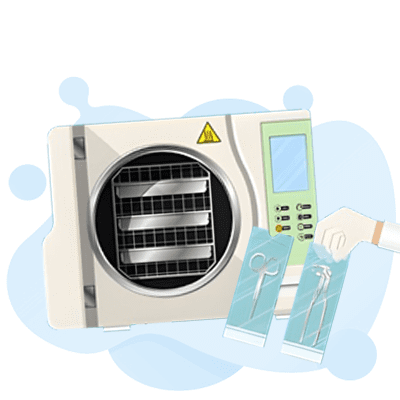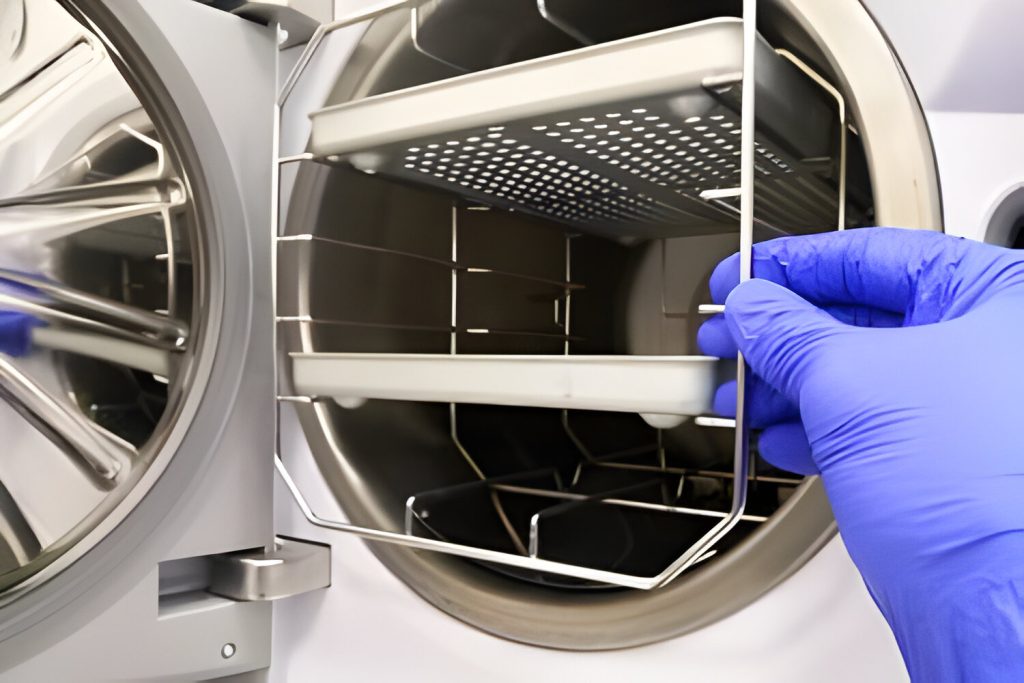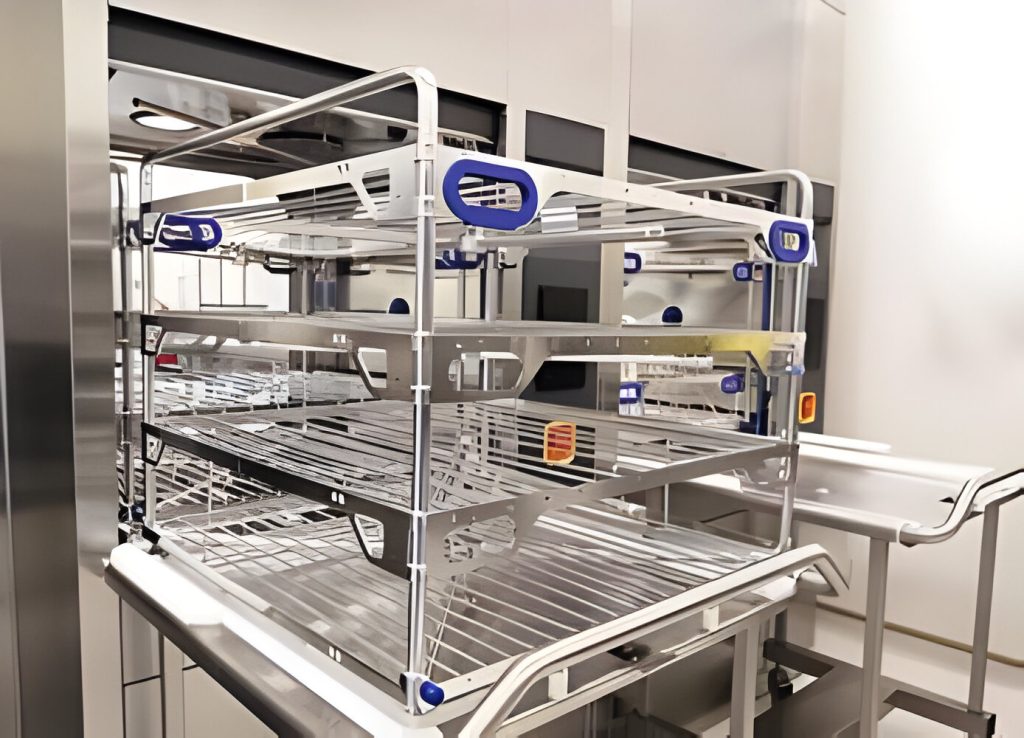CSSD Operations: Sterilization Excellence & Safety

Welcome to our comprehensive guide on CSSD operations, where we delve into the critical aspects of achieving sterilization excellence while ensuring safe management of medical equipment and sterile supplies. As healthcare professionals, we understand the vital role that CSSD plays in maintaining the highest standards of patient care and safety.
In the fast-paced world of healthcare, CSSD operations are the backbone of efficient and effective sterilization processes. It is essential to uphold stringent protocols and guidelines to eliminate the risk of infection and maintain the integrity of medical equipment and sterile supplies. By doing so, we can safeguard the well-being of patients and healthcare providers alike.
Throughout this article, we will explore the inner workings of CSSD departments, from the responsibility of a Central Sterile Services Department to the key principles that govern CSSD operations. We will also highlight the significance of CSSD equipment maintenance, quality control, and the indispensable role of skilled sterile processing technicians.
Join us as we delve into the world of CSSD operations, uncovering the best practices, industry standards, and the relentless pursuit of sterilization excellence.
Free CSSD Practice Test Online
Key Takeaways:
- CSSD operations are crucial for achieving sterilization excellence and ensuring the safety of medical equipment and sterile supplies.
- Adhering to stringent protocols and guidelines is essential to eliminate the risk of infection and maintain the integrity of medical equipment.
- CSSD equipment maintenance, quality control, and skilled sterile processing technicians play a vital role in providing optimal patient care.
- By upholding industry standards and implementing best practices, CSSD departments contribute to a safe and efficient healthcare environment.
- Continuous education and training are essential for CSSD professionals to stay updated with the latest advancements in sterilization technologies and procedures.
Understanding CSSD: Central Sterile Services Department 2025
A Central Sterile Services Department (CSSD) plays a vital role in healthcare facilities by ensuring the safe management of sterile supplies and the proper sterilization of medical instruments and equipment. Understanding the functions and responsibilities of a CSSD is crucial for maintaining high standards of patient safety and infection control.
The CSSD’s Role in Sterile Processing
The CSSD is responsible for handling all aspects of sterile processing, including the cleaning, decontamination, sterilization, and distribution of medical instruments and equipment. These meticulous processes are essential for preventing the transmission of infections and maintaining the integrity of sterile supplies.
Instrument Sterilization and Sterile Supply Management
Instrument sterilization is a critical task within the CSSD. High-quality sterilization methods, such as steam sterilization, ethylene oxide (ETO) sterilization, and hydrogen peroxide plasma sterilization, are used to ensure that medical instruments are free from pathogens and other contaminants.
The CSSD is also responsible for managing sterile supplies to ensure their availability and proper usage throughout the healthcare facility. This includes inventory control, expiration monitoring, and efficient replenishment strategies to prevent any disruptions in patient care.
Adhering to CSSD Standards and Best Practices
To maintain the highest level of safety and effectiveness, CSSDs follow rigorous standards and guidelines. These standards often come from organizations such as the Association for the Advancement of Medical Instrumentation (AAMI), the Centers for Disease Control and Prevention (CDC), and regulatory bodies like the Food and Drug Administration (FDA).
Implementing best practices in CSSD operations involves staying up to date with industry advancements, utilizing modern sterilization technologies, and continuously improving processes for optimal efficiency and effectiveness. Regular training and education for CSSD staff are essential to ensure compliance with evolving standards and best practices.
The Central Sterile Services Department (CSSD) plays a vital role in healthcare facilities, encompassing sterile processing, instrument sterilization, and sterile supply management. By adhering to CSSD standards, healthcare providers can ensure the safety and effectiveness of medical instruments and equipment, ultimately contributing to improved patient outcomes and reduced healthcare-associated infections.

Key Principles of CSSD Operations
When it comes to ensuring the highest standards of sterilization and safety in healthcare facilities, CSSD operations play a vital role. CSSD, which stands for Central Sterile Services Department, follows a set of key principles to maintain excellence in their processes. Adhering to CSSD standards, implementing proper sterilization procedures, and following CSSD guidelines and best practices are essential in providing optimal care to patients and minimizing the risk of healthcare-associated infections (HAIs).
CSSD standards are a set of regulations and protocols designed to ensure effective sterilization and sterile supply management. These standards encompass various aspects of CSSD operations, including the handling and processing of medical equipment and supplies, to maintain a clean and safe environment for both patients and healthcare professionals.
Sterilization procedures are a crucial part of CSSD operations. These procedures involve using the appropriate techniques and equipment to eliminate all microorganisms, including bacteria, viruses, and fungi, from medical equipment and supplies. CSSD professionals follow strict sterilization protocols to prevent the transmission of infections and maintain the integrity of sterile supplies.
CSSD guidelines provide a framework for CSSD operations and best practices. These guidelines can include recommendations for instrument sterilization, storage of sterile supplies, and quality control measures. By adhering to these guidelines, CSSD departments can ensure consistency, efficiency, and high-quality standards in their operations.
CSSD Best Practices
| Best Practices | Description |
|---|---|
| Regular Training and Education | Continuously update the knowledge and skills of CSSD staff to stay updated with the latest advancements in sterilization techniques and equipment. |
| Routine Equipment Maintenance | Regularly inspect, maintain, and calibrate CSSD equipment to ensure optimal performance and accurate sterilization processes. |
| Adherence to Infection Control Protocols | Strictly follow infection control protocols, including hand hygiene, use of personal protective equipment, and proper handling of contaminated materials. |
| Quality Assurance and Quality Control | Implement robust quality assurance programs to monitor and evaluate the effectiveness of sterilization processes and ensure compliance with standards. |
| Documentation and Record-Keeping | Maintain accurate and detailed records of sterilization processes, equipment maintenance, and quality control measures for reference and audits. |
By embracing CSSD standards, adopting proper sterilization procedures, and implementing CSSD guidelines and best practices, healthcare facilities can enhance patient safety, minimize the risk of HAIs, and achieve excellence in sterile supply management. The commitment to these key principles reinforces the critical role of CSSD operations in maintaining a safe and clean environment for the delivery of quality healthcare services.
Ensuring Excellence: CSSD Equipment Maintenance and Quality Control
One of the key aspects of maintaining sterilization excellence in a Central Sterile Services Department (CSSD) is the proper maintenance of CSSD equipment. Regular maintenance ensures that the equipment functions optimally, reducing the risk of contamination and improving efficiency in the sterilization process.
The Importance of CSSD Equipment Maintenance
CSSD equipment, such as sterilizers, washers, and dryers, undergoes constant use and undergoes wear and tear. Regular maintenance not only extends the lifespan of the equipment but also minimizes the chances of breakdowns or malfunctions during critical sterilization processes. By following manufacturer recommendations and conducting routine inspections and repairs, CSSD personnel can identify and address any issues promptly, ensuring reliable performance.
A well-maintained CSSD equipment fleet also plays a crucial role in ensuring patient safety. By adhering to maintenance schedules, CSSD professionals can significantly reduce the risk of equipment failure, prevent delays in surgical procedures, and avoid potential surgical site infections.
Effective Sterile Supplies Management
In addition to equipment maintenance, efficient management of sterile supplies is paramount for CSSD operations. Sterile supplies, including instruments, trays, and packs, must be stored properly to prevent contamination and maintain their sterility.
Establishing clear inventory control procedures, implementing correct storage techniques, and ensuring a sterile environment for storage areas are essential for maintaining the integrity of sterile supplies. Regular audits and monitoring of supply levels can help identify potential shortages and prevent stockouts, minimizing disruptions in service.
Rigorous CSSD Quality Control
Quality control is an integral part of CSSD operations to ensure the effectiveness of the sterilization process and adherence to industry standards. CSSD professionals must implement rigorous quality control measures to verify the efficacy of sterilizers, sterilization cycles, and packaging processes.
Quality control checks may include verifying sterilization parameters using biological indicators, conducting routine validation tests on sterilizers, and performing periodic audits of sterilization documentation. These measures help identify any deviations or weaknesses in the sterilization process, allowing for timely corrective actions to be taken.
CSSD Certification Requirements
To uphold the highest standards of sterilization excellence, CSSD personnel must comply with certification requirements. Accreditation bodies, such as the Association for the Advancement of Medical Instrumentation (AAMI) and the Joint Commission, set standards and provide guidelines for CSSD operations.
Certification programs ensure that CSSD professionals are trained and knowledgeable in the best practices of sterilization, equipment maintenance, and quality control. To obtain and maintain certification, CSSD personnel must attend training programs, pass competency assessments, and stay updated with industry advancements and regulatory changes.
In conclusion, CSSD operations must prioritize equipment maintenance, sterile supplies management, quality control, and compliance with certification requirements to attain sterilization excellence. By investing in regular maintenance, implementing effective management strategies, upholding rigorous quality control measures, and meeting certification standards, CSSD professionals can ensure the safety of medical equipment and sterile supplies, ultimately safeguarding patient health and well-being.
Skilled Workforce: The Role of a Sterile Processing Technician
Within the CSSD, the role of a sterile processing technician is of utmost importance. These skilled professionals play a critical role in ensuring the safety and effectiveness of medical device sterilization procedures. Their responsibilities encompass a range of tasks, including the proper handling, cleaning, and packaging of instruments and equipment.

The Responsibilities of a Sterile Processing Technician
A sterile processing technician is responsible for meticulously following strict protocols to ensure that all medical instruments and equipment are properly cleaned, decontaminated, and sterilized. They play a crucial role in preventing the spread of infections by ensuring that medical devices are free from harmful microorganisms.
These professionals are trained to inspect instruments for damage or wear, disassemble equipment when necessary, and thoroughly clean each item using approved techniques and cleaning agents. They carefully follow standardized protocols for sterilization, which may involve using heat, gas, or chemical processes.
Once the sterilization process is complete, sterile processing technicians meticulously pack and organize the instruments and equipment, ensuring they are ready for immediate use. They are responsible for maintaining accurate records of all sterilization processes, including dates, times, and methods used.
The Importance of Perfection in Sterilization Procedures
Medical device sterilization is a critical aspect of healthcare operations. It is imperative that sterile processing technicians perform their duties with the utmost care and attention to detail to ensure the safety of patients and healthcare providers. The consequences of inadequate sterilization can be severe, leading to infections, complications, and even loss of life.
Sterile processing technicians must be well-versed in the latest sterilization techniques, ensuring that they stay updated on best practices and industry guidelines. This knowledge enables them to maintain a sterile and safe environment within the CSSD, preventing the transmission of infections and protecting patients from harm.
Continuous Training and Professional Development
In addition to their initial training, sterile processing technicians must engage in ongoing education and professional development to stay informed about the latest advancements in medical device sterilization. This ensures that they continue to provide high-quality services and adhere to the ever-evolving industry standards.
By continuously honing their skills and expanding their knowledge, sterile processing technicians contribute to the overall excellence and safety of CSSD operations. Their dedication plays a vital role in maintaining the highest level of patient care and preventing the spread of infections.
The Role of a Sterile Processing Technician
A sterile processing technician is an essential part of the CSSD team, responsible for performing medical device sterilization procedures. Their responsibilities include handling, cleaning, and packaging instruments and equipment. Adhering to strict protocols and following industry guidelines, these skilled professionals ensure the safety and effectiveness of sterilization processes, preventing the spread of infections. Continuous training and professional development are crucial for maintaining proficiency in the latest sterilization techniques, enabling sterile processing technicians to contribute to the overall excellence and safety of CSSD operations.
Conclusion
In conclusion, CSSD operations play a vital role in achieving sterilization excellence and ensuring the safety of medical equipment and sterile supplies. By following CSSD standards and guidelines, healthcare facilities can maintain the highest level of cleanliness and prevent the spread of infections.
Throughout this article, we have highlighted the key principles of CSSD operations, including sterile processing, instrument sterilization, and sterile supply management. We have emphasized the importance of equipment maintenance, quality control, and the role of skilled sterile processing technicians.
Adhering to best practices and certification requirements is essential for CSSD success. By prioritizing sterilization excellence and safe management of medical equipment, CSSD professionals contribute significantly to patient safety and the overall quality of healthcare.